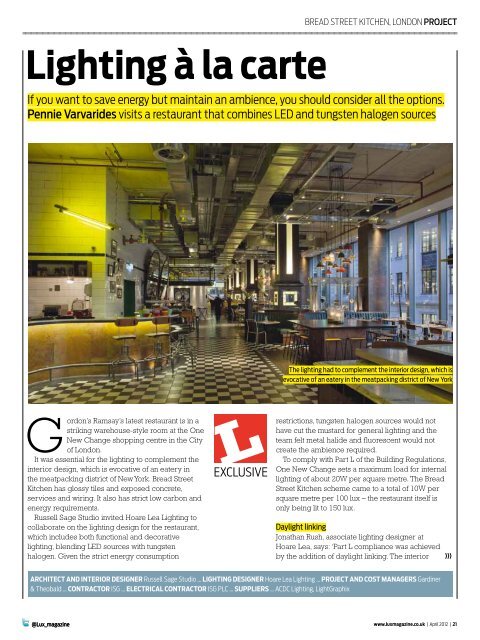to read full article... - Hoare Lea
to read full article... - Hoare Lea
to read full article... - Hoare Lea
- TAGS
- hoare
- hoarelea.com
You also want an ePaper? Increase the reach of your titles
YUMPU automatically turns print PDFs into web optimized ePapers that Google loves.
Lighting à la carte<br />
If you want <strong>to</strong> save energy but maintain an ambience, you should consider all the options.<br />
Pennie Varvarides visits a restaurant that combines LED and tungsten halogen sources<br />
Gordon’s Ramsay’s latest restaurant is in a<br />
striking warehouse-style room at the One<br />
New Change shopping centre in the City<br />
of London.<br />
It was essential for the lighting <strong>to</strong> complement the<br />
interior design, which is evocative of an eatery in<br />
the meatpacking district of New York. B<strong>read</strong> Street<br />
Kitchen has glossy tiles and exposed concrete,<br />
services and wiring. It also has strict low carbon and<br />
energy requirements.<br />
Russell Sage Studio invited <strong>Hoare</strong> <strong>Lea</strong> Lighting <strong>to</strong><br />
collaborate on the lighting design for the restaurant,<br />
which includes both functional and decorative<br />
lighting, blending LED sources with tungsten<br />
halogen. Given the strict energy consumption<br />
Architect And interior designer Russell Sage Studio … Lighting designer <strong>Hoare</strong> <strong>Lea</strong> Lighting … Project And cost mAnAgers Gardiner<br />
& Theobald … contrAc<strong>to</strong>r ISG … eLectricAL contrAc<strong>to</strong>r ISG PLC … suPPLiers … ACDC Lighting, LightGraphix<br />
@Lux_magazine<br />
EXCLUSIVE<br />
BREAD STREET KITCHEN, LoNDoN Project<br />
The lighting had <strong>to</strong> complement the interior design, which is<br />
evocative of an eatery in the meatpacking district of New York<br />
restrictions, tungsten halogen sources would not<br />
have cut the mustard for general lighting and the<br />
team felt metal halide and fluorescent would not<br />
create the ambience required.<br />
To comply with Part L of the Building Regulations,<br />
One New Change sets a maximum load for internal<br />
lighting of about 20W per square metre. The B<strong>read</strong><br />
Street Kitchen scheme came <strong>to</strong> a <strong>to</strong>tal of 10W per<br />
square metre per 100 lux – the restaurant itself is<br />
only being lit <strong>to</strong> 150 lux.<br />
Daylight linking<br />
Jonathan Rush, associate lighting designer at<br />
<strong>Hoare</strong> <strong>Lea</strong>, says: ‘Part L compliance was achieved<br />
by the addition of daylight linking. The interior<br />
〉〉〉<br />
www.luxmagazine.co.uk | April 2012 | 21
Project BREAD STREET KITCHEN, LoNDoN<br />
22 | www.luxmagazine.co.uk | April 2012<br />
@Lux_magazine
〉〉〉<br />
is encompassed by six-metre-high windows,<br />
which let us use linked control <strong>to</strong> reduce energy<br />
consumption. This was used in conjunction with<br />
scene-setting control <strong>to</strong> create atmosphere and<br />
further cut energy use.’<br />
Without daylight linking or scene setting, the<br />
@Lux_magazine<br />
scheme – including back-of-house lighting –<br />
consumes about 20W per square metre. This<br />
included the reclaimed decorative feature lights,<br />
which were dimmed considerably. Excluding the<br />
reclaimed decorative features, the fixed lighting<br />
installation load was under 11W per square metre 〉〉〉<br />
www.luxmagazine.co.uk | April 2012 | 23
Project BREAD STREET KITCHEN, LoNDoN<br />
Daylight linking and scene setting are<br />
essential <strong>to</strong> the scheme’s efficiency<br />
〉〉〉<br />
and functional downlighting alone was 4.85W<br />
per square metre.<br />
<strong>Hoare</strong> <strong>Lea</strong> worked with ACDC <strong>to</strong> choose the<br />
best LED chip for the project based on colour<br />
temperature, efficacy, spectral distribution and beam<br />
angle. The LED luminaires emit light at 2700K – good<br />
colour distribution in visible wavelengths that shows<br />
food at its best.<br />
Design objective<br />
A key interior design objective was <strong>to</strong> use reclaimed<br />
chandeliers and low level Anglepoise-style lamps<br />
for table lighting. For these elements, <strong>Hoare</strong> <strong>Lea</strong> did<br />
not believe LED retrofit lamps could offer the colour,<br />
impression or dimmability needed, so it specified<br />
efficient halogen candle lamps instead. <strong>Hoare</strong><br />
<strong>Lea</strong> says the restaurant will be updated when the<br />
‘technology catches up’.<br />
Rush explains: ‘B<strong>read</strong> Street Kitchen is a snapshot<br />
of the current situation with energy-efficient lighting<br />
and high-end aspirational interiors. A <strong>full</strong> LED<br />
scheme would have compromised the ambience<br />
and so a hybrid solution was developed. It is energy<br />
efficient, feels comfortable and adds <strong>to</strong> the appeal of<br />
the restaurant.<br />
When the functionality and light quality of LED<br />
retrofit lamps catches up with the energy savings<br />
available, it is likely that B<strong>read</strong> Street Kitchen will<br />
actually get more efficient.’<br />
24 | www.luxmagazine.co.uk | April 2012<br />
Operations manager at Gordon Ramsay Holdings,<br />
Alex Pitchford, was pleased that the scheme<br />
is so efficient. He says: ‘<strong>Hoare</strong> <strong>Lea</strong> Lighting’s<br />
solution complements the interior design concept<br />
developed by Russell Sage Studio and gives an<br />
added dimension <strong>to</strong> the dining experience at<br />
B<strong>read</strong> Street Kitchen while achieving an energyefficient<br />
scheme.’<br />
ENERGY DASHBOARD<br />
52 lm/W<br />
Lamp lumens<br />
Linear LEDs in the handrail of the staircase downlight<br />
the stair t<strong>read</strong>s and wash the mesh side panels<br />
4.85W/m2 Energy<br />
48 lm/W<br />
Luminaire lumens<br />
The restaurant conforms <strong>to</strong> Part L of the Building Regulations 2006, which demands<br />
that lighting in new commercial buildings achieve 45 luminaire lumens per circuit<br />
watt. Planning regulations meant the designers were not allowed <strong>to</strong> categorise any<br />
lighting as ‘display’, which would have allowed 15 lm/W. Without daylight linking<br />
and scene setting the scheme’s energy consumption <strong>to</strong>tals just under 20W per<br />
square metre, with a <strong>to</strong>tal consumption of 19.9kW for all lighting – decorative and<br />
functional. If only the functional lighting is considered, the <strong>to</strong>tal energy consumption<br />
drops <strong>to</strong> less than 5kW.<br />
@Lux_magazine


